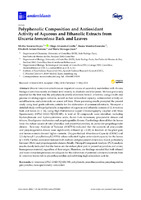Mostrar el registro sencillo del ítem
Polyphenolic composition and antioxidant activity of aqueous and ethanolic extracts from Uncaria tomentosa bark and leaves
| dc.contributor.author | Navarro-Hoyos, Mirtha | |
| dc.contributor.author | Alvarado-Corella, Diego | |
| dc.contributor.author | Moreira-Gonzalez, Ileana | |
| dc.contributor.author | Arnaez-Serrano, Elizabeth | |
| dc.contributor.author | Monagas-Juan, Maria | |
| dc.date.accessioned | 2018-06-14T20:15:29Z | |
| dc.date.available | 2018-06-14T20:15:29Z | |
| dc.date.issued | 2018 | |
| dc.identifier.uri | https://hdl.handle.net/2238/9796 | |
| dc.description | Artículo científico | es |
| dc.description.abstract | Uncaria tomentosa constitutes an important source of secondary metabolites with diverse biological activities mainly attributed until recently to alkaloids and triterpenes. We have previously reported for the first-time the polyphenolic profile of extracts from U. tomentosa, using a multi-step process involving organic solvents, as well as their antioxidant capacity, antimicrobial activity on aerial bacteria, and cytotoxicity on cancer cell lines. These promising results prompted the present study using food grade solvents suitable for the elaboration of commercial extracts. We report a detailed study on the polyphenolic composition of aqueous and ethanolic extracts of U. tomentosa bark and leaves (n = 16), using High Performance Liquid Chromatography coupled with Mass Spectrometry (HPLC-DAD/TQ-ESI-MS). A total of 32 compounds were identified, including hydroxybenzoic and hydroxycinnamic acids, flavan-3-ols monomers, procyanidin dimers and trimers, flavalignans–cinchonains and propelargonidin dimers. Our findings showed that the leaves were the richest source of total phenolics and proanthocyanidins, in particular propelargonidin dimers. Two-way Analysis of Variance (ANOVA) indicated that the contents of procyanidin and propelargonidin dimers were significantly different (p < 0.05) in function of the plant part, and leaves extracts showed higher contents. Oxygen Radical Absorbance Capacity (ORAC) and 2,2-diphenyl-1-picrylhidrazyl (DPPH) values indicated higher antioxidant capacity for the leaves (p < 0.05). Further, correlation between both methods and procyanidin dimers was found, particularly between ORAC and propelargonidin dimers. Finally, Principal Component Analysis (PCA) analysis results clearly indicated that the leaves are the richest plant part in proanthocyanidins and a very homogenous material, regardless of their origin. Therefore, our findings revealed that both ethanol and water extraction processes are adequate for the elaboration of potential commercial extracts from U. tomentosa leaves rich in proanthocyanidins and exhibiting high antioxidant activity. | es |
| dc.language.iso | spa | es |
| dc.publisher | Instituto Tecnológico de Costa Rica | es |
| dc.rights | acceso abierto | es |
| dc.rights.uri | https://creativecommons.org/licenses/by-nc-sa/4.0/ | * |
| dc.subject | Antioxidantes | es |
| dc.subject | Extracción -- Etanol | es |
| dc.subject | Polifenoles | es |
| dc.subject | Extractos | es |
| dc.subject | Uña de gato | |
| dc.subject | Espectrometría de masas | |
| dc.subject | Antioxidants | |
| dc.subject | Extraction -- Ethanol | |
| dc.subject | Polyphenols | |
| dc.subject | Extracts | |
| dc.subject | Uncaria tomentosa | |
| dc.subject | Mass spectrometry | |
| dc.title | Polyphenolic composition and antioxidant activity of aqueous and ethanolic extracts from Uncaria tomentosa bark and leaves | es |
| dc.type | artículo original | es |
Ficheros en el ítem
Este ítem aparece en la(s) siguiente(s) colección(ones)
-
Artículos [40]



